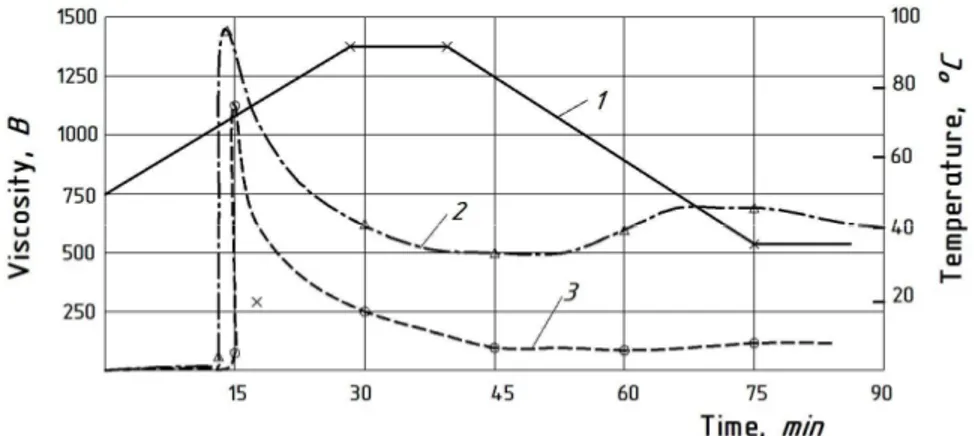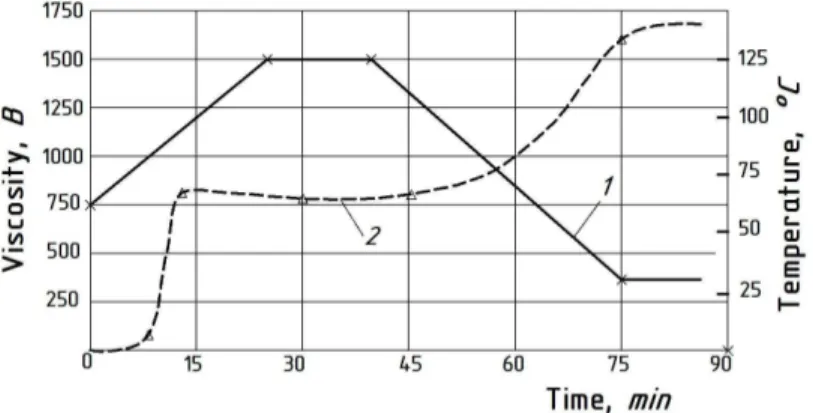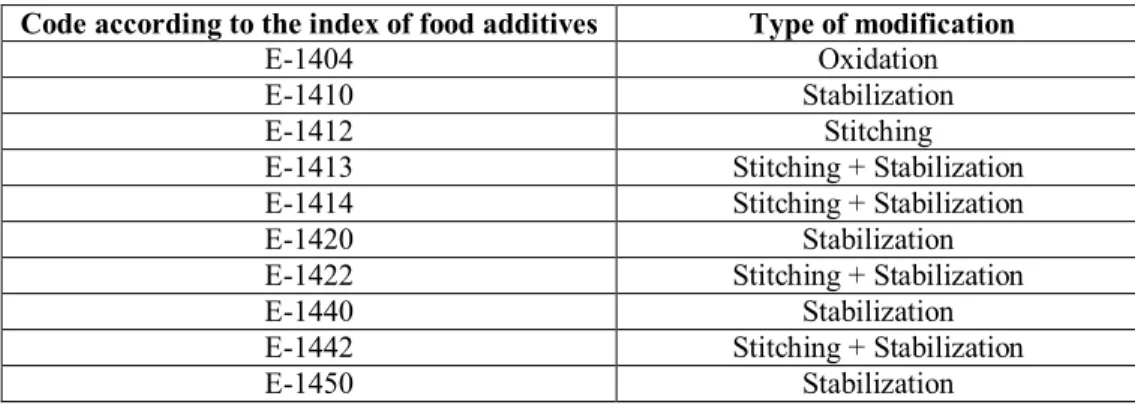Effect of starch as hydrocolloids for formation of a
stable emulsion system in food
Oksana Lugovska1, Vasyl Sydor1, Iliana Kostova2 1-National University for Food Technologies, Kyiv, Ukraine 2-University of Ruse “Angel Kanchev”, branch Razgrad, Bulgaria
Abstract Keywords:
Starch Native Modified Viscosity
Article history:
Received 25.01.2014 Received in revised form
26.03.2014
Accepted 16.04.2014
Corresponding author:
Oksana Lugovska E-mail:
Oksana.Lugovska@ rambler.ru
Іntroduction. It is necessary to determine the effect of the physicochemical properties of native and modified starches in their use in food.
Matherials and methods. Investigated two samples of food emulsions using starches of different nature of origin (native, modified starch). Using laboratory balances, volume of cylinders determined percentage of water separation during freezing and unfreezing emulsions; Brukfild viscometer measured the viscosity increase depending on the time, temperature and pH of food emulsions.
Results. When freezing / unfreezing emulsion of native starch in the first cycle of water has been separated by 8% in the second cycle of 38%, the third 50%, in contrast to the emulsion with modified starch water separation starts from the fourth cycle slightly, in the fifth cycle percentage of water separation is 1%, the sixth cycle of 3 %.
As a result, studies of viscosity versus time, temperature and pH of food emulsions proved that in an acidic medium at pH 6.5 viscosity emulsion with modified starch is stored and then increases over a longer time compared with the emulsion of native starch where the viscosity at the beginning of the storage period increases and then decreases.
Introduction
Modern manufacturers merganser at their disposal are dozens or hundreds of titles and some special products combined title starch, where each product has its own specific characteristics and scope. Without claiming to be a complete analysis of starch produced special, try to capture the most significant features.
It all starts with the selection of raw materials. Having known iodine - starch reaction, it is easy to see that all starches except derived from waxy maize, iodine stained in dark blue. The next difference is seen iodine - starch complex under a microscope shows that starch is composed of numerous granules, and, depending on the raw granules have a different shape and size. Interestingly, potato starch is a mixture of both small and very large grains of which are several times larger than grains of corn or tapioca starch.
If you delve starch at the molecular level, it appears that the starch granules are composed of two types of natural polymer molecules - polysaccharides. Line polysaccharide called amylose and branched - amylopectin (Figure 1).
Amilose Starch polymers
Amilopectine
Fig. 1.
As Table 1 shows the main characteristics of some species of native starches, on which most often produce modified starches for special and industrial processes.
As can be seen from the Table 1, another significant parameter by which to judge the properties of starch are gelation temperature. This - the temperature of water is typically 5% - solution of starch in which granules start to swell and bind water.
Thus, even when discussing the raw material for the manufacture of starch, there are certain criteria to choose a product: potato starch has a low gelation, corn and corn highamiloze has the ability to form gels, tapioca - clean neutral taste waxy corn - past consistency and the most stable texture. Why, despite the many variations of native starches, is a constant development and implementation of special starches or modified (not to be confused with genetic modification). Why, well working jelly "native starch is rarely used as a thickener in products with any significant shelf life?
Table 1
The origin of the
starch the granules, mk The diameter of Temperature of gelation, °С Amylose content,%
Corn 5-30 62-80 25
Wax corn 5-30 63-72 <1
Hyghamilozna corn 5-30 63-92 50-90
Potato 5-100 58-65 20
Topioka 4-35 52-65 17
Rice 1-3 68-78 19
Wheat 1-45 52-85 25
Matherials and methods
Investigated two samples of food emulsions using starches of different nature of origin (native, modified starch). Emulsions were prepared by following the recipes.
Emulsion for drinks
Recipe for 1000 kg of finished product
Unit Variations recipes
Name of raw materials 1 2
Native starch (Wax corn) kg - 120
Modified starch kg 120 -
Orange oil kg 55 55
Rezynogum kg 55 55
Colorant kg 15,5 15,5
Citric acid kg 5 5
Sodium benzoate kg 2,5 2,5
Water kg 747 747
Total kg 1000 1000
Brukfild viscometer measured the viscosity increase depending on the time, temperature and pH of food emulsions.
Results and discussion
There are several factors that hinder the wide industrial application of native starches as thickeners - stabilizers:
• Syneresis (water separation during storage and frozen); • Uncontrolled change in viscosity when heated;
• A sharp decrease in viscosity in acidic medium, as well as overheating and homogenization ;
• Long sticky texture;
• Change in texture during storage.
In order to overcome these limit, developed a number of special modified starches. As mentioned earlier, changes in texture during storage and display syneresis connect with presence in linear polymer amylose starch. One can imagine is schematically as line amylose obtained by brewing from the interior of the granules and distributed evenly throughout the volume of the solution.
However, the storage of linear amylose molecules can fit around each other and formed associates. This phenomenon is called retrogradation starch, as a result, there is a separation of the water and the texture of a product containing amylose, changes over time with the gradual formation of a gel.
Following the statement of facts in order to reduce and eliminate syneresis texture changes during storage is most suitable starch from waxy maize, which contains almost no amylose. However, despite the lack of amylose, one can imagine that the linear part of amylopectin is also able to associate. This can lead to syneresis during storage.
In order to avoid such associations in the molecular structure of starch introduce additional volume substitutes which interfere with the convergence of linear parts of amylopectin. From a chemical point of view volume substitutes are the esters of starch. This modification is called stabilization and provides a starch that holds water without a noticeable manifestation of syneresis for a long shelf life and modes of freeze/thaw. Figure 2 shows the diagram depending percent of separated water with starch paste, depending on the number of cycles a deep freeze (-27 ° C) and thawing.
0 10 20 30 40 50 60
1 2 3 4 5 6
Number of cycles
W
at
er
s
ep
ar
at
io
n,
%
Modified starch Native starch
Fig. 2. The percentage of water separation during freezi and unfreezing of emulsions with native and modified starches
When freezing / unfreezing emulsion of native starch in the first cycle of water has been separated by 8% in the second cycle of 38%, the third 50%, in contrast to the emulsion with modified starch water separation starts from the fourth cycle slightly, in the fifth cycle percentage of water separation is 1%, the sixth cycle of 3 %.
Therefore, the stabilization modification eliminates syneresis and change the texture for long term storage and freeze thawing modes.
In order to describe how a change in the viscosity of native starch under the influence of temperature, acidic and homogenization, consider the so-called Brabender diagram (figure 3)
Fig. 3. The dynamics of the viscosity of native starch
It shows a graph of the viscosity of the 5 % suspension of starch is heated in water at neutral and acidic environment in the absence of mechanical action. Direct the figure is a graph of temperature change (right axis) with time (bottom scale). Curve shows the change in viscosity (left scale) in the same time frame (lower scale)
As can be seen from the diagram, until the temperature gelation practically no starch water binding and viscosity not change. After reaching the temperature gelation seen a dramatic increase in viscosity. In this case, the starch granules begin to swell, form water and increase in size. Achieving peak viscosity means that most of the starch granules reached its maximum size and maximum water-retaining characteristics. When failure occurs subsequent recording of pellets, resulting in a decrease in viscosity and water - reducing ability. The same effect leads and mechanical action (homogenization) after brewing starch. As can be seen from the graph, in acidic medium viscosity decreases much faster. This is due to hydrolysis of starch polymer molecules.
The above properties of native starches leads to the fact that they use in manufacturing processes can lead to blockage of the heat exchanger (with high peak viscosity) , and the viscosity of the output of the production process varies greatly and often unpredictable depending on the combination of temperature and mechanical stress. In addition, the use of native starches in foods with acidic environment leads to a decrease in viscosity due to hydrolysis.
These shortcomings of native starches was overcome by strengthening the internal structure of the granules by means of so -called “ mating” (cross - linkage) or cross-linking.
Example diagram Brabendera modified starch is shown in figure 4. It can be clearly seen no peak viscosity or viscosity drop during heating.
Fig. 4. The dynamics of the viscosity of modified starch
1 - pH=7 2 - pH<7
Сonclusions
The most common nowadays classical starch - thickener, which combine simultaneously two types of modifications: stabilization and crosslinking. Thus, it is important so-called «depth modification ", the number of modifying units, per molecule of starch. Thus, the deepening of stabilization - modification, except water- enhancing features, allows reducing point gelation starch. However, «overload ", especially acetyl fragments can cause unwanted interaction of the modified starch with milk proteins. Increased «cross- coupling» can get starches, which are characterized by high resistance to the conditions of the process (temperature, homogenization, exposure to an acidic environment). However, the more resistant to external influences starch, the lower viscosity makes it soft working conditions. Therefore, in each case, selecting the optimum starch, should take into account as much as possible the conditions of a particular process.
According to ISO 4380:2005 «Modified starch». General specific at the most common nowadays classical starch - thickener, which combine simultaneously two types of modifications: stabilization and crosslinking. Thus, it is important so-called «depth modification ", the number of modifying units, per molecule of starch. Thus, the deepening of stabilization - modification, except water- enhancing features, allows reducing point gelation starch. However, «overload”, especially acetyl fragments can cause unwanted interaction of the modified starch with milk proteins. Increased «cross- coupling «can get starches, which are characterized by high resistance to the conditions of the process (temperature, homogenization, exposure to an acidic environment ). However, the more resistant to external influences starch, the lower viscosity makes it soft working conditions. Therefore, in each case, selecting the optimum starch, should take into account as much as possible the conditions of a particular process.
The following (Table 2) are the special starch approved for use in the food industry , most of which modified method described above .ions " modified starch - a starch obtained due to physical , chemical, biochemical or combined processing of natural starch to change its properties. As you can see from the definition, modified starches not related to genetically modified foods. Starch modified without interfering with the structure of DNA, he acquires the required properties using very different transformations.
The following (Table 2) are the special starch approved for use in the food industry, most of which modified method described above.
Table 2
Code according to the index of food additives Type of modification
Е-1404 Oxidation
Е-1410 Stabilization
Е-1412 Stitching
Е-1413 Stitching + Stabilization Е-1414 Stitching + Stabilization
Е-1420 Stabilization
Е-1422 Stitching + Stabilization
Е-1440 Stabilization
Е-1442 Stitching + Stabilization
The most widely used in the food industry, thanks to a good combination of price / quality found from waxy maize (E1422). These are used as thickeners, stabilizers in the production of various types of yogurt and fruit flavours. The main advantage of these starches is stability against syneresis due to lack of amylose and shiny surface by small granules.
E1412 priori has lowered resistance to syneresis and less "work" mode freezing and thawing in what he is missing a stabilization type of modification, but the absence of amylose still allows the use of E1412 derived from waxy maize in dairy products as a thickener.
Modification E1414 is most often used for tapioca and potato starches. Despite the presence in this case, two types of modifications: "cross- coupling" and "stability" are usually (E1414) based on tapioca and potato amylose due to having less stable during storage and less resistant to syneresis.
The most functional today is the modification E1442. It distinguishes high storage stability, using the freeze-thaw and against syneresis. Low viscosity prevents hot block (brewing) pasteurizers, facilitates mass transfer and thermal conductivity.
Due to global market trends related to the concept of healthy eating, recently developed special starches - analogues modified in 1422, but chemically modified and are not a food additive. In foods in the U.S. and the EU are declared as ordinary natural starch.
Summary of the types of modifications should be noted that one and the same modification can be made using different materials and with different depth, which ultimately determines the specific properties of modified starch.
References
1. Borisenko O.V., Alekseev Yu.A., Klimov S., (2002), Metody sozdaniya vysokoko-ntsentrirovannykh vkusovykh emul'sii dlya bezalkogol'nykh napitkov, pishchevykh ingredientov, Syr'e i dobavki, 2, pp. 18-19.
2. Pszczola D.E., (2001), How Ingredients Help Solve Beverage Problems, Food Technology / Products and Technologies, 55(10).
3. Bogach A. Aromatic emulsion for manufacture of soft drinks, Food & Drinks, Food &
Beverage, 2003; № 4 - S. 10-11.
4. Galileu Rupollo, Nathan Levien Vanier, Elessandra da Rosa Zavareze, Maurício de Oliveira, Juliane Mascarenhas Pereira, Ricardo Tadeu Paraginski, Alvaro Renato Guerra Dias, Moacir Cardoso Elias. (2011), Pasting, morphological, thermal and crystallinity properties of starch isolated from beans stored under different atmospheric conditions, Carbohydrate Polymers, 86(3), pp. 1403-1409.
5. Byrd S. J. (2001), SAIB - the oldest new ingredient for the beverage market, Food / Nutrition Laboratory, Kingsport.
6. Nelson D.L. & Cox M. (2004), Book principled biochemistry.
7. Melnik O., Dovgun I. (2013), Modified starch properties, Ukrainian Food Journal, 2(3), pp. 354-359.
8. Primo-Martín P., Nieuwenhuijzen N.H., Hamer R.J., Vliet T. (2007), Crystallinity changes in wheat starch during the bread-making process: Starch crystallinity in the bread crust, Journal of Cereal Science, 45(2), pp. 219-226.
9. Susanne L. Jensen, Fan Zhu, Varatharajan Vamadevan, Eric Bertoft, Koushik Seetharaman, Ole Bandsholm, Andreas Blennow (2013), Structural and physical properties of granule stabilized starch obtained by branching enzyme treatment,
10. Nathan Levien Vanier, Elessandra da Rosa Zavareze, Vânia Zanella Pinto, Bruna Klein, Fabiana Torma Botelho, Alvaro Renato Guerra Dias, Moacir Cardoso Elias. (2012), Physicochemical, crystallinity, pasting and morphological properties of bean starch oxidised by different concentrations of sodium hypochlorite, Food Chemistry, 131(4), pp. 1255-1262.
11. Hernández-Jaimes C., Bello-Pérez L.A., Vernon-Carter E.J., Alvarez-Ramirez J. (2013), Plantain starch granules morphology, crystallinity, structure transition, and size evolution upon acid hydrolysis, Carbohydrate Polymers, 95(1), pp. 207-213.
12. Fillips G.O., Vil'yams P.A. (2006), Spravochnik po gidrokolloidam, GIORD, Sankt-Peterburg.
13. Litvyak V.V., Roslyakov Yu.F., Butrim S.M., Kozlova L.N. (2013), Krakhmal i
krakhmaloprodukty: monografіya, Krasnodar.
14. Litvyak V.V., Roslyakov Yu.F. (2013), Mekhanizm khimicheskoy modifikatsii krakh mala, Izvestiya vysshikh uchebnykh zavedeniy. Seriya Pishchevaya Tekhnologiya, 2(3), S. 31–35.
15. Vladimir Litvyak, Valentina Moskva, Ol'ga Romashko, Nikolay Yurkshtovich, Fedor Kaputskiy. (2012), Mekhanizm khimicheskoy modifikatsii krakhmala, Nauka i
innovatsii: nauchno-prakticheskiy zhurnal, 9(115), pp. 64–69.
16. A. Simitchiev, T. Petrova, M. Ruskova, N. Penov (2014), Effect of extrusion variables on the dynamic viscosity of extruded lentil flours, Journal of food and packaging
Science, Technique and Technologies, 4, рр 50-54.
17. Litviak V.V., Lisovska D.P., Hrabovska O.V. (2011), Porivnialna otsinka vlastyvostei deiakykh vydiv krokhmaliu ta yikh vplyv na yakist khlibnykh vyrobiv, Tsukor Ukrainy, 4(64), pp. 48–53.
18. V. Sukmanov, S. Stefanov, Y. Petrova, A. Golubev, I. Lagovskiy, D. Kristia (2014), Subcritical water extraction of reducing substances, Journal of food and packaging
Science, Technique and Technologies, 4, рр. 164-172.
19. Olga Rybak (2013), Some aspects of the formation of emulsions and foams in food industry, Ukrainian Journal of Food Science, 1(1), pp. 41-49.
20. Olexandr Lysyi, Vitaliy Pichkur, Olena Zapotocka, Olena Hrabovska, Volodymyr Kovbasa, Yelyzaveta Smirnova (2013), Effect of hydrocolloids on the stability of fruit fillings, Ukrainian Journal of Food Science, 1(2), pp. 217-222.
21. Litvyak V.V., Yurkshtovich N.K., Butrim S.M., V.V. (2013), Morfologiya krakhmala i
krakhmaloproduktov, Moscow.



